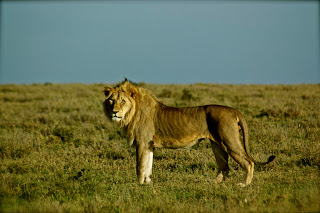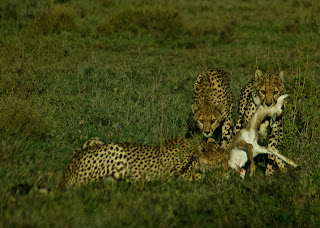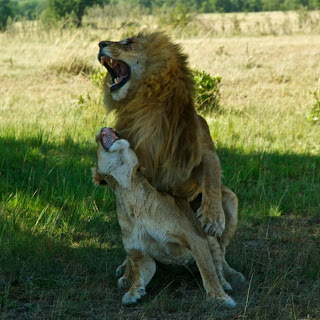‘Born Free’, by Joy Adamson is the first book I remember reading. I think that it was the book I was being read when I realized I could read faster myself than having someone read to me. I loved the stories of camping in the bush for long periods of time, the adventures of walking and driving through the bush on expeditions, and of course having your own lion to accompany you in the bush. As much of a dream of mine as it was, I never imagined I would end up driving around the bush, climbing rocky outcrops to watch the sun go down, or sneaking up on elephants at a waterhole on foot. I don’t own a lion to take with me on walks, but I work in one of the most amazing places on Earth, and sometimes that’s as good as owning it.

What a treat!
I’m currently in Serengeti for three weeks with a photographer, trying to photograph lions. Lions spend 16-22hrs of the day sleeping, but if you get up early enough you often see them moving around, or at least sitting up. They actually often hunt around 2 p.m. when everyone is back in camp having dessert and getting ready for their siestas.
Male lions roar tomake contact with other lions in their pride, and to let intruders know how strong they are. This is the most handsome lion of the Sayari pride. To really appreciate this, you need to plug speakers in or wear headphones.
I started working in this area 6 years ago when I was running Suyan camp, just outside the park. It was a beautiful camp and I have some special memories of walking the area with a couple of Maasai, my teaching them the English names of birds and plants, and their teaching me their traditional uses for plants. The concept behind the camp was to provide opportunities that couldn’t be had in the park like night drives, walks, and sundowners on ridges with bonfires. Sometimes I would convince guests to take the mattresses off their beds and we would arrange them around the fire and sleep under the stars.
Occasionally we would drive across the northern part of the park to the edges of the Mara River. The area had been closed to tourists for a period of time because of a rise in poaching and some violent encounters between tourists and poachers. Resident wildlife numbers were down, but during the dry months elsewhere in the Serengeti, this area got rain and the migrating wildebeest would move in. I won’t go into details of why wildebeest migrate, but I’ve written about it on another blog (safari ecology). Working together with Serengeti’s rangers, and also working in the villages adjacent to the park, Asilia took a risk and put up a camp called Sayari. When Suyan had no guests, I would pop over to Sayari and help out with the guiding. Sayari was a success, and within a couple of years other companies got the drift and now, during the dry season, this is one of the busiest areas in the national park.
Busyness is not necessarily negative, and tourists on game drive are effectively extra rangers on patrol, which makes operating quite difficult for the poachers, so poaching decreased when the tourists arrived. Lions were scarce at that time, as was other game, but the population of wild animals began to increase. It took three years for Asilia to build the first permanent camp here, and in doing so they set the bar for luxury camps in Serengeti.
I began coming here in the off-season, when the wildebeest weren’t here, helping out with the walking safaris. Then last year, when I came up in March, I saw over 50 lions here (see blog). This explosion in the lion population is evidence that there’s also more prey.
Lions live in prides made up of a core of females, usually related. Prides are territorial, and the more females in a group, the more successful they are at keeping intruding prides out, and also expanding their territories when food is scarce. Larger prides also have higher success rates of raising cubs. Males take over prides when they fully mature at about 5 years old. In order to be reproductively successful, a male lion needs to rule a pride for at least 2 years, which is long enough for his cubs to reach independence. This forces lions to form coalitions to keep intruding males out. It is still too early in this area’s renaissance to see much stability, and therefore pride territories and dynamics are ever-changing. However, some of the prides are growing.
The pride above Sayari consists of 2 male lions. Coalitions of 2 males are often not related, though coalitions of 4 or more are. In this case, one is older than the other. There are at least 7 lionesses in this pride and there are 12 cubs that were born sometime mid-December.
The Cubs.
Such an amazing sight. The mothers killed a zebra this morning in an epic ambush. There will be plenty of milk to go around. These poor two lionesses were being harassed by all the cubs who were thirsty.
As I follow the pride for the next couple weeks, I will enjoy it on my own for the most part. In a way, it is the dream that I’m living.




























































































































